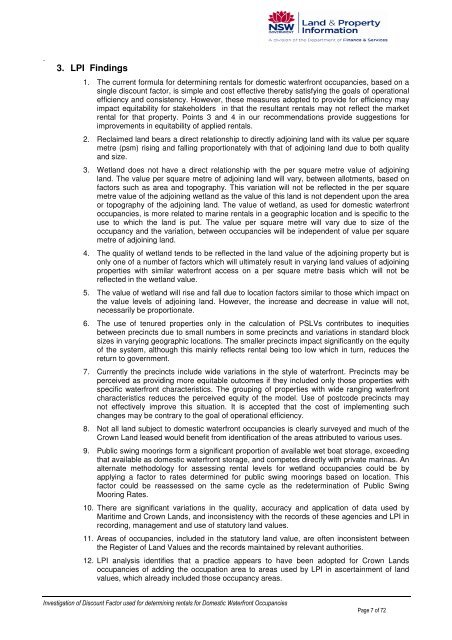Consultant Report - IPART
Consultant Report - IPART
Consultant Report - IPART
Create successful ePaper yourself
Turn your PDF publications into a flip-book with our unique Google optimized e-Paper software.
.<br />
3. LPI Findings<br />
1. The current formula for determining rentals for domestic waterfront occupancies, based on a<br />
single discount factor, is simple and cost effective thereby satisfying the goals of operational<br />
efficiency and consistency. However, these measures adopted to provide for efficiency may<br />
impact equitability for stakeholders in that the resultant rentals may not reflect the market<br />
rental for that property. Points 3 and 4 in our recommendations provide suggestions for<br />
improvements in equitability of applied rentals.<br />
2. Reclaimed land bears a direct relationship to directly adjoining land with its value per square<br />
metre (psm) rising and falling proportionately with that of adjoining land due to both quality<br />
and size.<br />
3. Wetland does not have a direct relationship with the per square metre value of adjoining<br />
land. The value per square metre of adjoining land will vary, between allotments, based on<br />
factors such as area and topography. This variation will not be reflected in the per square<br />
metre value of the adjoining wetland as the value of this land is not dependent upon the area<br />
or topography of the adjoining land. The value of wetland, as used for domestic waterfront<br />
occupancies, is more related to marine rentals in a geographic location and is specific to the<br />
use to which the land is put. The value per square metre will vary due to size of the<br />
occupancy and the variation, between occupancies will be independent of value per square<br />
metre of adjoining land.<br />
4. The quality of wetland tends to be reflected in the land value of the adjoining property but is<br />
only one of a number of factors which will ultimately result in varying land values of adjoining<br />
properties with similar waterfront access on a per square metre basis which will not be<br />
reflected in the wetland value.<br />
5. The value of wetland will rise and fall due to location factors similar to those which impact on<br />
the value levels of adjoining land. However, the increase and decrease in value will not,<br />
necessarily be proportionate.<br />
6. The use of tenured properties only in the calculation of PSLVs contributes to inequities<br />
between precincts due to small numbers in some precincts and variations in standard block<br />
sizes in varying geographic locations. The smaller precincts impact significantly on the equity<br />
of the system, although this mainly reflects rental being too low which in turn, reduces the<br />
return to government.<br />
7. Currently the precincts include wide variations in the style of waterfront. Precincts may be<br />
perceived as providing more equitable outcomes if they included only those properties with<br />
specific waterfront characteristics. The grouping of properties with wide ranging waterfront<br />
characteristics reduces the perceived equity of the model. Use of postcode precincts may<br />
not effectively improve this situation. It is accepted that the cost of implementing such<br />
changes may be contrary to the goal of operational efficiency.<br />
8. Not all land subject to domestic waterfront occupancies is clearly surveyed and much of the<br />
Crown Land leased would benefit from identification of the areas attributed to various uses.<br />
9. Public swing moorings form a significant proportion of available wet boat storage, exceeding<br />
that available as domestic waterfront storage, and competes directly with private marinas. An<br />
alternate methodology for assessing rental levels for wetland occupancies could be by<br />
applying a factor to rates determined for public swing moorings based on location. This<br />
factor could be reassessed on the same cycle as the redetermination of Public Swing<br />
Mooring Rates.<br />
10. There are significant variations in the quality, accuracy and application of data used by<br />
Maritime and Crown Lands, and inconsistency with the records of these agencies and LPI in<br />
recording, management and use of statutory land values.<br />
11. Areas of occupancies, included in the statutory land value, are often inconsistent between<br />
the Register of Land Values and the records maintained by relevant authorities.<br />
12. LPI analysis identifies that a practice appears to have been adopted for Crown Lands<br />
occupancies of adding the occupation area to areas used by LPI in ascertainment of land<br />
values, which already included those occupancy areas.<br />
Investigation of Discount Factor used for determining rentals for Domestic Waterfront Occupancies<br />
Page 7 of 72
















